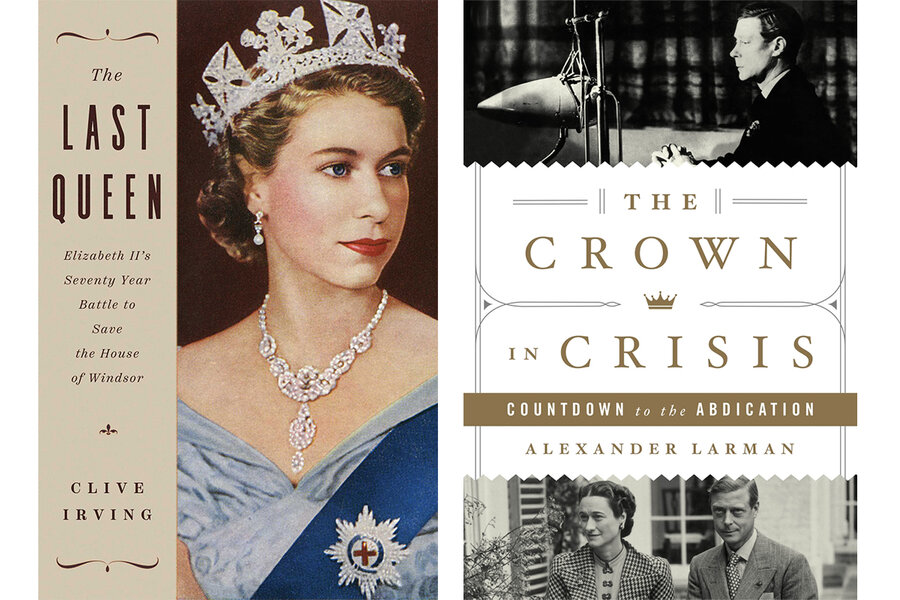The Windsor saga: Two peerless books on the British royal family
Loading...
It’s been 85 years since King Edward VIII’s reign formally ended when the British Parliament passed the Abdication Act on Dec. 11, 1936. The saga is recounted by journalist Alexander Larman in “The Crown in Crisis: Countdown to the Abdication.” Edward’s departure brought an end to the shortest reign – just 326 days – since Lady Jane Grey’s nine days in 1553 and put Edward’s brother on the throne as King George VI.
At the heart of the abdication story was an American divorcée named Wallis Warfield Simpson. Edward met her while he was the beloved Prince of Wales, and although his father, crusty old King George V, hated even the mention of this interloper, Edward became obsessed with her. Even after George’s sudden death made him king, he was determined to marry Simpson – though she was an commoner with two former husbands still living and he was now the head of the Church of England.
Following closely such earlier accounts as Philip Ziegler’s 1990 “King Edward VIII: The Official Biography,” Larman takes readers through the byzantine maneuverings behind the scenes. Key figures include Prime Minister Stanley Baldwin, who was insistent that the very idea of a Queen Wallis was unthinkable, and the members of the evanescent “King’s Party,” who stubbornly believed that Edward should have his way.
It’s clear that Larman has much sympathy for Simpson; one ludicrous pronouncement is that she “had all the pitfalls of enormous fame, and only a few of its compensations.” Edward, on the other hand, is described as a “wretched, quixotic ruler, an obsessed and demanding lover and, bar the odd instance of compassion and decency, a selfish and thoughtless man.” Their shared Nazi sympathies, meanwhile, are mentioned mainly as political predicaments and not moral failings.
When Parliament voted on the Abdication Act – which would essentially send Edward into exile – Larman notes that James Maxton, chairman of the Independent Labour Party, called the monarchy “the symbol of a class-ridden society” and openly hoped it would come to an end with the abdication.
That didn’t happen, of course, but it’s a sentiment that has hovered over the institution during the extraordinarily long reign of Edward’s niece, Queen Elizabeth II. Observers across the political spectrum have said that it’s inconceivable for the monarchy to end while Elizabeth is queen – and equally inconceivable that it should continue once she’s gone.
The deep sources of this sentiment are the subject of longtime royal reporter Clive Irving’s new book “The Last Queen: Elizabeth II’s Seventy Year Battle to Save the House of Windsor.” Irving opens his book with a stark pronouncement: “Queen Elizabeth II is the longest-reigning monarch in British history and will likely be the last Queen of England.”
The pages of “The Last Queen” sketch out her biography as a series of embarrassments and tragedies. In each pugnacious and incredibly readable chapter, Irving reexamines all the famous crises of Elizabeth’s reign, from the various scandals of Princess Margaret to the popularly sanctified figure of Diana Spencer (“The specific human cause [of her death],” he sternly writes, “was a drunken chauffeur along with the fact that she was not wearing a seatbelt”).
He can occasionally overestimate the interest in his own personal story. But he’s fascinating when he dissects, for instance, what’s known of the “cupidity” and “depravity” that began to come to light connecting Prince Andrew to the late convicted sex offender Jeffrey Epstein. And he spares some withering insights for Prince Harry and Meghan Markle, the Duke and Duchess of Sussex, who made headlines last year when they stepped away from the monarchy (“Months before they announced their exit on Instagram,” he notes, “they were building a website with a trademarked logo, Sussex Royal”).
It ends up being a bleak picture of “a family that has become patently dysfunctional,” and it sometimes stirs Irving to virtually bilious ire: “The monarchy is not one family’s property, although they act as though it is; it belongs to the people, who pay for it.”
Even readers not kindly disposed toward the House of Windsor may find this a bit harsh. Irving’s irritation notwithstanding, it’s difficult to look at Queen Elizabeth’s long service and see somebody who selfishly thinks the monarchy is her own property. But these two books combine to make the end of the Windsor monarchy seem not only inevitable but imminent.
The Queen celebrates her 95th birthday this year, and a staggering 69 years on the throne. Her mother lived to be 101, but even so, will the world see a King Charles III? Or a King William V?








